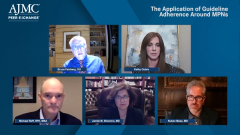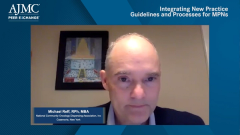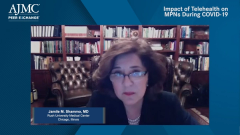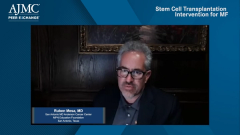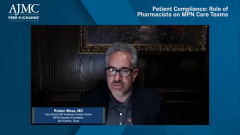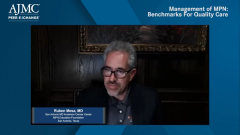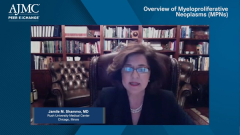
Diagnosis of MPNs
Ruben Mesa, MD, discusses presentation and diagnosis of MPNs as well as life expectancies of ET [essential thrombocythemia], PV [polycythemia vera], and MF [myelofibrosis].
Episodes in this series

Bruce Feinberg, DO: When we think about these patients, these are 3 separate diseases. Do they happen to the same kind of patients? Are these diseases of aging? Is it aging, tired bone marrow that starts to mutate and has these clonal populations evolve? Are they similar in terms of onset or symptomatology? They can affect all cell lines, although certain cell lines predominate in each case. If you can get me that patient journey, what do these patients typically look like for each of these individual disease and to what extent do they overlap?
Ruben Mesa, MD: That is an interesting question, Bruce. In terms of the biology—we do not have all the biology worked out—we believe that there are clones in the bone marrow that, over time, become activated and turn into an MPN [myeloproliferative neoplasm]. At the American Society of Hematology Annual Meeting, there was a suggestion that the process might even begin in utero, in a fetus, so there is a tie to aging. Why does 1 person end up developing the disease vs another? That we do not know.
We know that aging is certainly a part of it. Overall, it is a disease of aging with median ages in the mid 60s, but there are clearly much younger individuals who are afflicted. I would break how they present to us as doctors, whether they go to their primary care doctor or to a hematologist, into 3 buckets. With ET [essential thrombocythemia] and PV [polycythemia vera], both of these are the earlier MPNs.
There are some patients who present asymptomatically in whom we find elevations in the red blood cell count, platelet count, and/or white blood cell count at the time of a routine complete blood count, in a general physical. These patients might present because they had an unexpected thrombotic event such as an unexpected DVT [deep vein thrombosis] or PE [pulmonary embolism]. They may have symptoms that have developed, like fatigue, itching, headaches, and night sweats. The other group is individuals with myelofibrosis [MF]. They have more myeloproliferative neoplasms. They might have progressed previously from having had PV or ET, sometimes for many years. They tend to have splenomegaly, so they will sometimes present because of the enlarged spleen as noted by them, their spouse, or their physician. They may present with anemia or worse symptoms like inadvertent weight loss, night sweats, bone pain, or those difficulties. There are several ways they can present. In all those circumstances, we are usually trying to exclude other potential causes before we make a diagnosis based on their bone marrow, the presence of a clonal marker, and their blood tests.
Bruce Feinberg, DO: Based on that, even the patient who presents with a mild elevation of a blood count without other explanation is still likely to go through a bone marrow aspiration biopsy to make sure it is not something more sinister.
Ruben Mesa, MD: If you can exclude a secondary cause, they may preclude it. For example, the most common reason for an elevation in a platelet count might be iron deficiency, so if you can identify that they have an iron deficiency, they are treated and recover. They may not have a bone marrow biopsy. The longer-term unexplained change in the blood count will usually require a bone marrow biopsy, so if I have a patient who is coming to me who has had 2 years of elevation of their platelet count, I am usually much more comfortable that there might be a bone marrow condition because these other things would likely have been identified or resolved prior to that point.
Bruce Feinberg, DO: What is the prognosis for the patients with ET, PV, and MF? Are we talking about years or decades? I realize that there are different factors, but could you give us a sense of the seriousness of these conditions?
Ruben Mesa, MD: This is a conversation I frequently have with patients. It takes a fair amount of health literacy to walk the path of what a neoplasm means for these conditions. Because individuals hear the word cancer, they associate it with pancreatic cancer, colon cancer, or a GBM [glioblastoma]. What we are talking about is something quite different.
I try to use the analogy of other chronic conditions, like rheumatoid arthritis or lupus. These are serious conditions, and they require medications. Many individuals who have them will live out their normal life expectancy, but there are individuals who could pass from those diseases. That is probably the best analogy for ET and PV. Patients with ET frequently have a diagnosis that is not too dissimilar from age-matched controls, but there are subsets within there who can surely progress. For the life expectancy of patients with PV, this is obviously in historical terms, but there are new therapies that might impact this. They likely have a slightly diminished natural history compared with controls, realizing that there are some cases that might be more dramatic.
Myelofibrosis is much more like a solid tumor in terms of its prognosis. On average, that survival might be 2 to 6 years. There is likely an improvement in survival with some of the therapies that are evolving. There is quite a distribution, meaning that there are some rare individuals who have long-lived myelofibrosis of 20 or 30 years, and there are others who have a prognosis of a year to a year and a half. It is quite variable, but ET and PV have a very different impact on life expectancy than myelofibrosis has.
Transcript edited for clarity.
Newsletter
Stay ahead of policy, cost, and value—subscribe to AJMC for expert insights at the intersection of clinical care and health economics.






